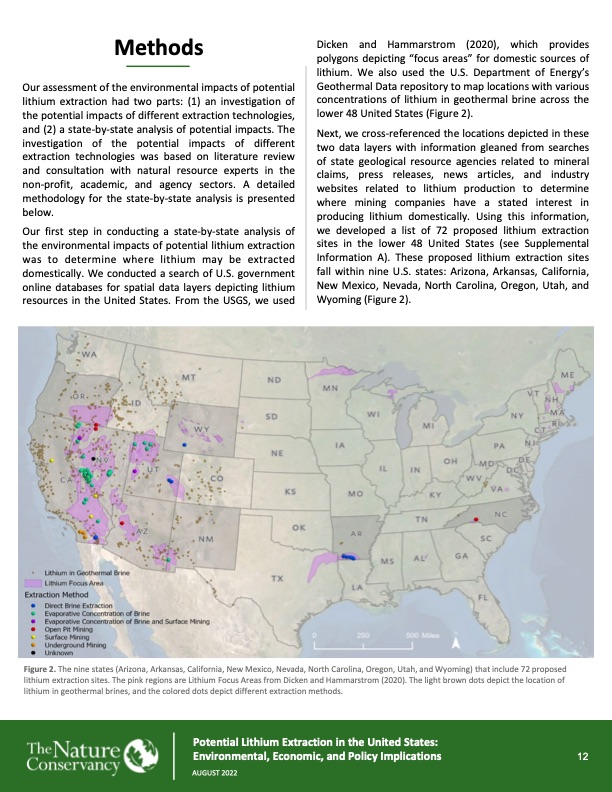
PDF Publication Title:
Text from PDF Page: 012
Methods Our assessment of the environmental impacts of potential lithium extraction had two parts: (1) an investigation of the potential impacts of different extraction technologies, and (2) a state-by-state analysis of potential impacts. The investigation of the potential impacts of different extraction technologies was based on literature review and consultation with natural resource experts in the non-profit, academic, and agency sectors. A detailed methodology for the state-by-state analysis is presented below. Our first step in conducting a state-by-state analysis of the environmental impacts of potential lithium extraction was to determine where lithium may be extracted domestically. We conducted a search of U.S. government online databases for spatial data layers depicting lithium resources in the United States. From the USGS, we used Dicken and Hammarstrom (2020), which provides polygons depicting “focus areas” for domestic sources of lithium. We also used the U.S. Department of Energy’s Geothermal Data repository to map locations with various concentrations of lithium in geothermal brine across the lower 48 United States (Figure 2). Next, we cross-referenced the locations depicted in these two data layers with information gleaned from searches of state geological resource agencies related to mineral claims, press releases, news articles, and industry websites related to lithium production to determine where mining companies have a stated interest in producing lithium domestically. Using this information, we developed a list of 72 proposed lithium extraction sites in the lower 48 United States (see Supplemental Information A). These proposed lithium extraction sites fall within nine U.S. states: Arizona, Arkansas, California, New Mexico, Nevada, North Carolina, Oregon, Utah, and Wyoming (Figure 2). Figure 2. The nine states (Arizona, Arkansas, California, New Mexico, Nevada, North Carolina, Oregon, Utah, and Wyoming) that include 72 proposed lithium extraction sites. The pink regions are Lithium Focus Areas from Dicken and Hammarstrom (2020). The light brown dots depict the location of lithium in geothermal brines, and the colored dots depict different extraction methods. Potential Lithium Extraction in the United States: Environmental, Economic, and Policy Implications 12 AUGUST 2022PDF Image | Potential Lithium Extraction in the United States

PDF Search Title:
Potential Lithium Extraction in the United StatesOriginal File Name Searched:
Lithium_Report_FINAL.pdfDIY PDF Search: Google It | Yahoo | Bing
Product and Development Focus for Infinity Turbine
ORC Waste Heat Turbine and ORC System Build Plans: All turbine plans are $10,000 each. This allows you to build a system and then consider licensing for production after you have completed and tested a unit.Redox Flow Battery Technology: With the advent of the new USA tax credits for producing and selling batteries ($35/kW) we are focussing on a simple flow battery using shipping containers as the modular electrolyte storage units with tax credits up to $140,000 per system. Our main focus is on the salt battery. This battery can be used for both thermal and electrical storage applications. We call it the Cogeneration Battery or Cogen Battery. One project is converting salt (brine) based water conditioners to simultaneously produce power. In addition, there are many opportunities to extract Lithium from brine (salt lakes, groundwater, and producer water).Salt water or brine are huge sources for lithium. Most of the worlds lithium is acquired from a brine source. It's even in seawater in a low concentration. Brine is also a byproduct of huge powerplants, which can now use that as an electrolyte and a huge flow battery (which allows storage at the source).We welcome any business and equipment inquiries, as well as licensing our turbines for manufacturing.| CONTACT TEL: 608-238-6001 Email: greg@infinityturbine.com | RSS | AMP |